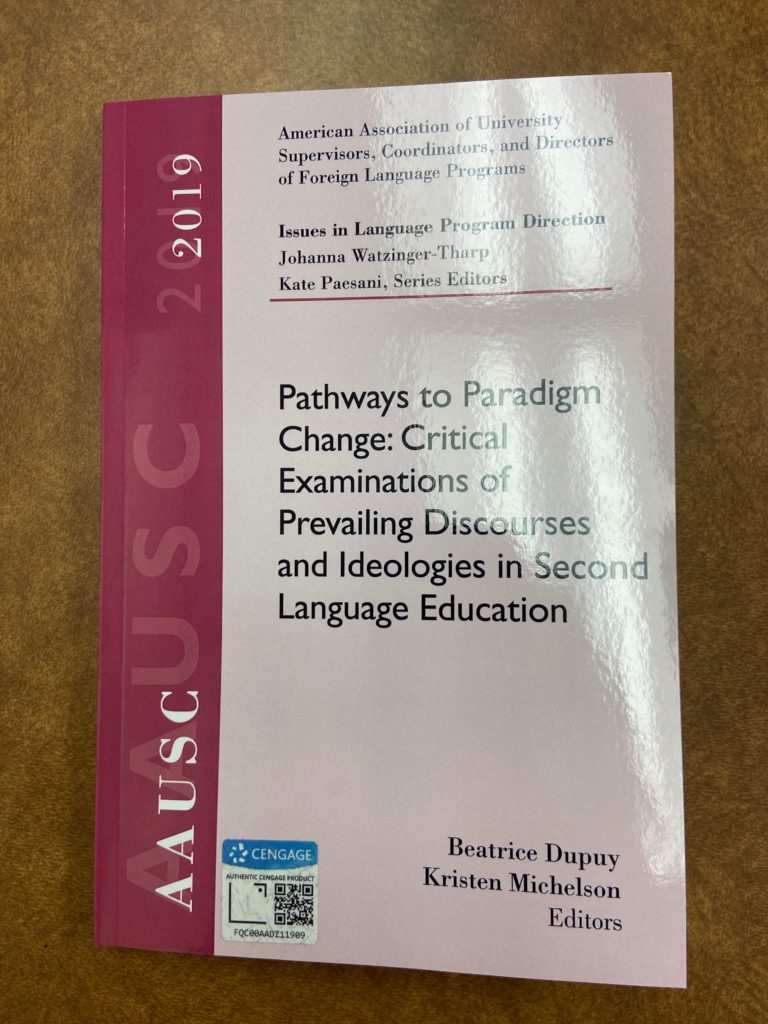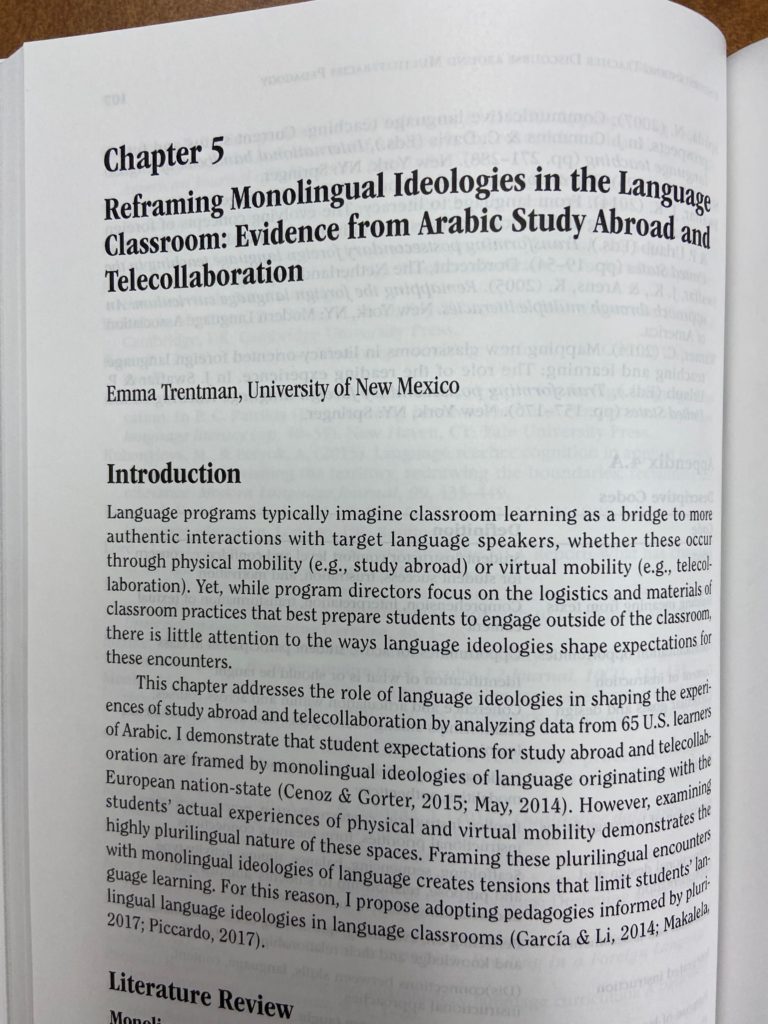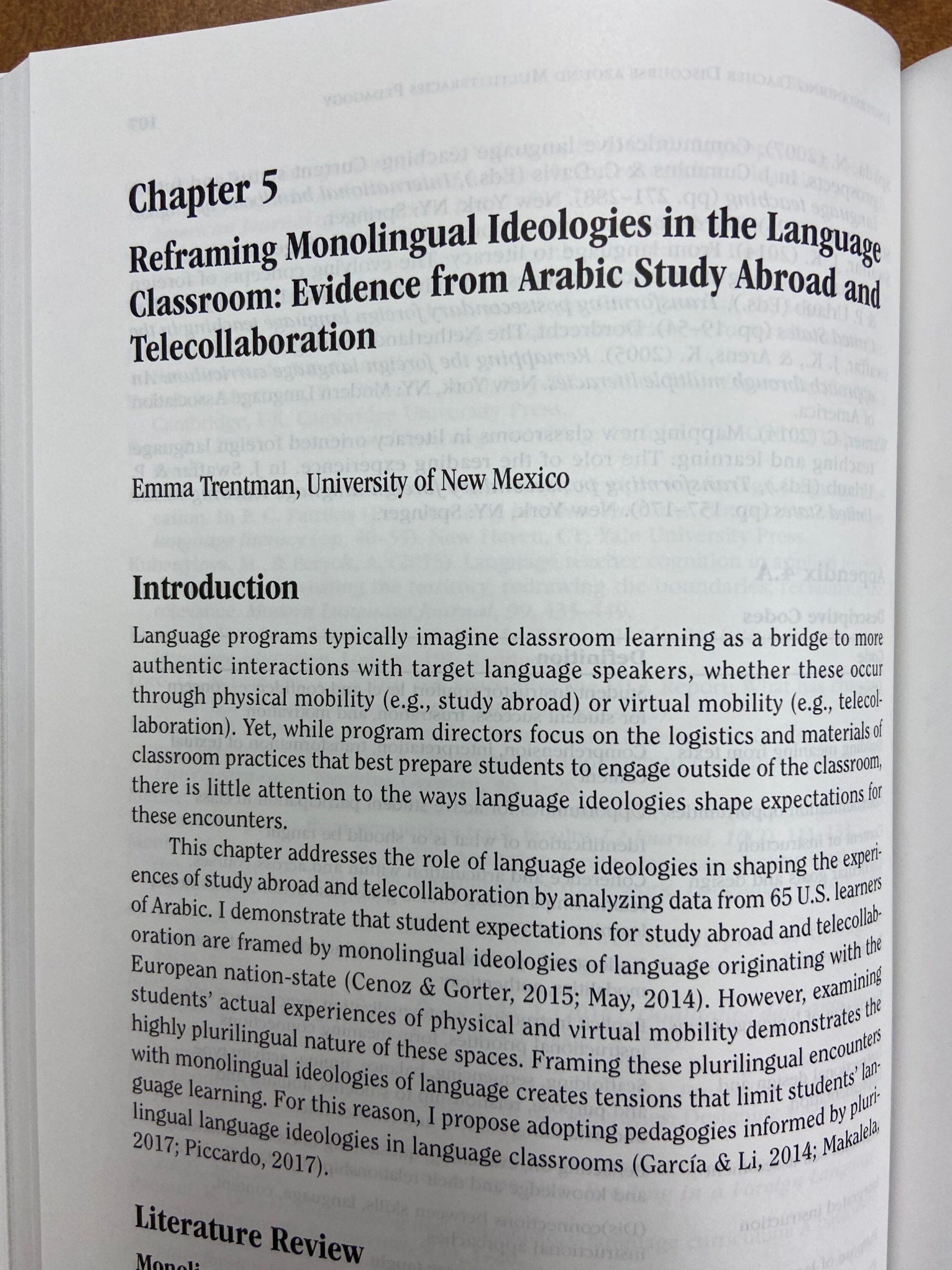Wednesday is the one day I teach in person this semester, and this past Wednesday was the first time I’d been to my office on campus since March. I was excited to discover the 2019 volume of the American Association of University Supervisors, Coordinators, and Directors of Foreign Language Programs (AAUSC) in my mailbox! The editors are Beatrice Dupuy and Kristen Michelson, and the collection is called “Pathways to Paradigm Change: Critical Examinations of Prevailing Discourse and Ideologies in Second Language Education”.

As you might imagine if you regularly read this blog, this is exactly the shift in second language education I think our field needs! I’m excited to read all of the chapters in this book, and today I’ll be highlighting my own contribution, which I’m excited to see in print.
A fun fact is that this is the 2019 volume with a 2021 publication date, which has made me confused as to how to cite it this year, but it turns out it had the right idea to skip 2020 all along!

My chapter, “Reframing Monolingual Ideologies in the Language Classroom: Evidence from Arabic Study Abroad and Telecollaboration” draws from three research projects. The first was my research on students spending a semester abroad in Egypt, the second a faculty-led study abroad program to Jordan that involved telecollaboration activities prior to the trip, and the third was a telecollaboration project in our second year classroom using TalkAbroad (which our wonderful Language Learning Center sponsors for language classes at UNM). Both of these contexts (study abroad and virtual exchange) are often presented as ideal opportunities for authentic target language interactions. My argument in this chapter is that the monolingual language ideologies that shape learners’ expectations for these encounters create tensions with the highly plurilingual nature of these physical and virtual spaces, and these tensions in fact limit opportunities for language learning. To resolve this, we need to pay more attention to how language ideologies shape our expectations for these encounters.
As I’ve discussed elsewhere on this blog, monolingual language ideologies focus on languages as separate, bounded, objects. They originate with European nationalism, where language and national boundaries were imagined as mutually reinforcing, and were exported worldwide via colonialism, where linguistic boundaries were also used to reinforce racial hierarchies. In language classrooms, we see the effect of monolingual language ideologies in the idealization of the native speaker (generally from a particular national, racial, ethnic, or class background), the assumption that knowledge of other languages and dialects “interferes” with acquisition, and the perceptions of a monolingual target language classroom environment as ideal.
In my chapter, I contrast this with plurilingual language ideologies, which are one term for an alternative set of language ideologies originating in pre- and post colonial contexts. These language ideologies view language boundaries as fluid and socially constructed. Their focus is on the linguistic repertoires of individuals, and the strategic choices they make in particular communicative contexts, rather than the extent to which these choices conform to socially prescribed language names. Individual linguistic repertoires are not static, but shift over time and with lived experiences.
So, how do these contrasting language ideologies impact our field? In my chapter, I show that learners’ expectations for their interactions during study abroad and virtual exchange were largely informed by monolingual language ideologies. They mapped spaces and speakers associated with Arab nations to Arabic, and expected monolingual Arabic immersion in these spaces, imagining that they would speak “only Arabic abroad” or evaluating their success in a virtual exchange by how little English they used. These included frustration with racial mappings of their language abilities, where White students felt that the expectation that they could not speak Arabic hindered their opportunities to use Arabic, and students of color sometimes felt frustrated that their national identity was questioned based on their race. Despite their frustrations with these racialized experiences, learners engaged in these same mappings themselves, expecting locals to always use Arabic (rather than their full linguistic repertoire including English) and fellow study abroad students to use English (unless in a program with a language pledge).
In short, these monolingual expectations contrasted sharply with the plurilingual realities of the study abroad and virtual exchange environments, and the actual linguistic repertoires of the learners (all of whom spoke English and had studied at least one language other than Arabic) and their interlocutors (frequently multilingual themselves). Examining what learners actually did with their linguistic repertoires abroad demonstrates that translanguaging practices were the norm and that these served a variety of functions, including using existing linguistic resources to access new ones, mapping language and social function, mapping language and topic, and establishing social connections.
Yet because these plurilingual realities were framed with expectations rooted in monolingual language ideologies, students generally interpreted their translanguaging practices from a monolingual perspective, expressing “frustration” or “regret” at their inability to remain monolingual, or feeling forced to choose between language practice and friendships. They also reproduced problematic mappings among race, nation, and language, despite their own frustration with these assumptions. Thus, this monolingual framing of plurilingual practices actually limited learners’ ability to pursue their language learning goals in plurilingual environments.
For this reason, as I’ve also explained on this blog, I think it is essential for us as language teachers to use pedagogies informed by plurilingual, rather than monolingual language ideologies. We can do this by reframing our existing practices to recognize the translanguaging in our classroom, and how these practices support language learning. We can also creating transformative spaces that engage with global Englishes as a reality rather than a threat, recognize the skills that multilingual and multidialectal students bring to the language classroom, even when studying languages unrelated to those in their current linguistic repertoires, and perhaps most importantly reckon with the global structural inequalities that shape our world.
If you’re interested in reading more, check out the chapter itself (contact me for access), as well as the rest of the book!
